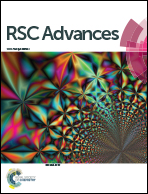Th(iv) recovery from aqueous waste via hollow fiber renewal liquid membrane (HFRLM) in recycling mode: modelling and experimental validation
Abstract
In the present work, the experimental investigation and mathematical modelling of Th(IV) recovery has been carried out by using the recycling mode of the hollow fiber renewal liquid membrane (HFRLM) process. Experiments were done at various operational conditions: the concentrations of TBP (tri-butyl phosphate) diluted in kerosene as a liquid membrane (LM), the nitrate and thorium(IV) ions concentration in the feed and flow rates of the feed and strip phases in the membrane module. The results indicate that practically more than 96% of thorium can be removed from an aqueous phase containing 198 ppm Th(IV) and 2 M NO3− by using the LM comprising of 30% (v/v) of TBP while the feed and stripping solutions were being circulated at the flow rates of 5.6 mL min−1 within 7 hours. In addition, a rigorous mathematical model has been developed to predict the experimental data. For this purpose, one-dimensional time dependent mass conservation equations in the longitude direction of the shell and lumen sides and in the radial direction of liquid membrane are numerically solved. The reasonable agreement between the experimental and the predicted data suggests the validity of the developed model. Therefore, this model might be useful for the design and optimization of the recovery of Th(IV) in the HFRLM process in the recycling mode.



 Please wait while we load your content...
Please wait while we load your content...